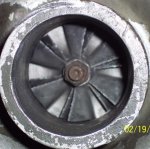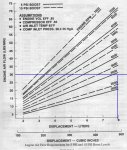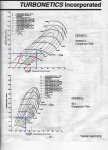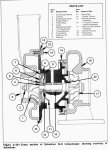Lee wrote-
Jwaller - I hope you have a spare turbo for your rig. If you've got the fuel cranked up enough to pull 18 PSI from a "D" turbo, that turbo is living on borrowed time unless you've got some other tricks you haven't told us about!
>cut<
BTW, the reason the "C" whines and the "D" doesn't has to do with design of the inlet vanes. As best as I recall, the "C" turbo inlet vanes are smaller and the air flow through the tips of the vanes goes supersonic, which is what causes the whine. The "D" turbo has larger inlet vanes, the air flow stays subsonic, thus no whine
Tired so hope not too many mistakes-
I always thought the pistons were the weak link.The LDS pistons are supposed to be stronger to handle its higher boost. Also increasing boost in engines not so designed can create head gasket problems. The solution in cars is to o-ring the block.( Rods seem least effected by power increases as that puts them in compression where metal is strongest.Their weakness is high RPM. The reversal at TDC puts rods(and bolts) in tension.This stess increases exponently...)
It would seem that a few more psi in the manifold would add little stress to the turbo . More air tends to cool the chamber and lower EGT(assuming charge temp is controlled, no addition fuel is added, and no excess present). But increasing boost increases charge temp and thus chamber temp and EGT. Adding fuel increases temp even more up to a point (that is why there is more power-hot gasses expand and push on the piston harder. Excess fuel burning in the exhaust( where there is no water jacket) send temps EGT thru the roof.
Increasing back pressure increases EGT. Too much can stress a turbo and even blow gasses back into the intake manifold.
At some point the compressor efficiency falls off .It becomes very inefficient heating the air more than compressing it (hot boost).The result is low performance and possible a damaged turbo( from high EGT or surge). Compressor maps(like a topographical map) also have a surge line. If it operates in the area past this line the compressor can become unstable and destroy itself.
Solutions for problems include a diff size turbos (or housing A/R ratio) , Air/Fuel ratio adjustments, aftercooling(desirable above 10-15psi), water/methanol injection.
The Mack I operate runs ~36psi (manifold). Multi stage tractor pull rigs exceed 250psi (manifold). Properly balanced turbos don't seem to mind the press
Its all about controlling EGT,fuel and charge temp. Just monitoring the EGT should protect most [turbo-wise].
As for EGT and turbines the duration is important. Gasoline engines run hotter than diesels. Perhaps the diff is they don't run at max output (and extreme EGT) for hours on end. Here is a good piece on EGT
http://www.bankspower.com/Tech_whyegt.cfm
As for the source of the whine I had always just assumed the turbine. Thanks for clarifying that for me.
I'm running out of time so will leave it to you all to keep me honest(point out my errors).
Here is my D's compressor impeller. Anyone have a pic of the C ?JimK







